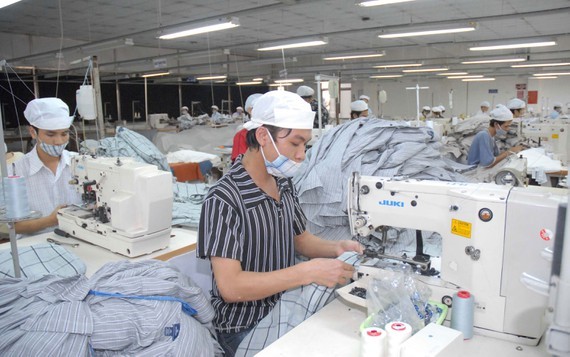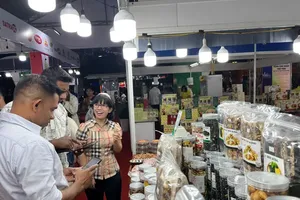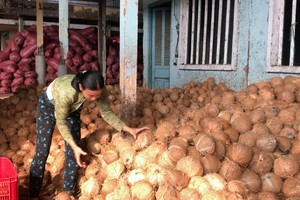
According to Mr. Pham Thanh Kien, Director of the Department of Industry and Trade of Ho Chi Minh City, the Covid-19 pandemic has affected the business results of enterprises in various sectors, proven by decreases or low increases compared to the same period last year in the results of norms in the first five months of this year.
Specifically, the index of industrial production was estimated to drop 7.2 percent; retail sales of goods were estimated to increase 8.4 percent while it rose 13.7 percent in the same period last year; total export turnover of city-based enterprises through border gates across the country was estimated to surge 6.3 percent while it gained 7.2 percent in the same period last year.
Fortunately, figures showed that the consumer market, including both domestic and export markets, of city-based enterprises in the first five months of this year maintained a fairly good growth; especially after the city dismissed the social distancing order, production, and business activities have been returning to normal since May. In comparison with the previous month, the index of industrial production climbed 7.9 percent; total retail sales of goods and service revenue jumped 20 percent; exports advanced 10 percent; imports augmented 15 percent.
‘This is a positive signal and I hope these results will be better in the remaining months of this year,’ he said.
According to a survey conducted at the end of April by the city’s Statistical Office, 85.5 percent of enterprises in the city were affected by the Covid-19 pandemic. Noticeably, some industries saw a high proportion of enterprises badly affected by the pandemic, such as leather and related products with 98.2 percent, accommodation service with 97.1 percent, catering service with 92.4 percent, travel agencies with 92.2 percent, textile with 90.3 percent, garment production with 89.9 percent, logistics with 87.1 percent, and retail with 87.1 percent.
From the management perspective, the Department of Industry and Trade realized that the pillar industries that are the economic motivation of the city are also the industries that encounter many difficulties amid the current situation. For instance, 87.1 percent of enterprises in the retail sector was affected by the Covid-19 because the income of people was influenced by the pandemic. From the beginning of this year to the end of April, the Business Association of Ho Chi Minh City and product line associations reported that the main difficulties were a shortage of raw materials, financial problems due to disruption in production, and narrowed consumption market.
Under this situation, the Department of Industry and Trade has carried out measures to remove difficulties for enterprises, and at the same time advised the city on proposal and recommendations to the Central. Industry and trade currently contribute about 35.5 percent to the city's economic scale. Of which, industry accounts for 20.8 percent, wholesale and retail accounts for 14.7 percent; The number of enterprises accounts for 53.6 percent of the total number of enterprises operating in the area. Therefore, removing difficulties for enterprises is also the main task of the department from now until the end of this year.
At present, the department has been carrying out two activities at the same time. Firstly, it regularly updates and determines the needs of enterprises. In May, the State Bank of Vietnam recorded 511 disadvantaged cases; of which, 57 cases have been solved, 324 cases continue to work with commercial banks to handle the situation, 101 cases are receiving consultancy, and 29 cases are not eligible to receive assistance. Secondly, it is expanding the domestic market, and implementing concentrated promotional campaigns, including the ’60 golden days of promotions in the city’ and the ‘Consumption stimulus in 2020’ programs.
These programs will integrate the traditional shopping channel and e-commerce with the maximum value of goods and services used for the promotional campaign up to 100 percent. Enterprises will be supported 100 percent of the costs for displaying, introducing, and selling products. The ‘Consumption stimulus in 2020’ program will be taken place in the form of a trade fair with a scale of 500 stalls to help city-based enterprises to promote the consumption of goods amid the context that the country has entered the stage of recovering production and business. Besides, to support enterprises to expand the market, in September this year, the city will organize a program to connect the supply and demand for goods between the city and other provinces and cities to continue to establish supply chains, bringing goods made in the city into the distribution network of other provinces and cities and vice versa.
Mr. Kien said that reviewing the past months, he has seen six opportunities, as well as lessons for both enterprises and authorities. Firstly, although industrial production declined compared to the same period last year, it is the reaction, production adjustment of enterprises upon signals of the market. The industrial production in the past five months of food and foodstuff processing industry, medicines, medicinal chemistry, and medicinal material manufacturing, and especially electronics industry still posted good growth. This has contributed to ensuring supply and demand for goods in the market, reducing the situation of high inventory as enterprises did not understand the market demand or the situation of a local shortage of goods that the city encountered previously.
Secondly, enterprises are increasingly paying more attention to developing the domestic market. Retail sales of goods in the first five months of this year still maintained a decent growth of 8.4 percent over the same period last year. This shows that on one hand, the purchasing power and consumer ability remain quite good. On the other hand, Vietnamese enterprises have increasingly created confidence in consumers through the quality of goods and services.
Thirdly, the habits and behaviors of choosing the shopping channel of consumers have changed and led to the change of the distribution network to suit consumers' needs. Through the survey, the purchasing power at supermarkets in the city in the past five months has increased by over 10 percent over the same period. During social distancing, people switched to do shopping online, which is a good opportunity to develop e-commerce and also contribute to the consumption of domestically-made goods.
Online shopping business is also developing strongly. Sales through the Internet (email and website) account for 42.1 percent of the total revenue of enterprises; The percentage of households using payment cards and bank transfers when shopping is 30.8 percent. Enterprises have paid attention to making intensive investments for the operation of e-commerce websites; 33 percent of enterprises have built independent websites with diverse features, allowing consumers to order and make payments online. These are good things that need to be promoted in the future.
Fourthly, the connection of enterprises is more and more improved, for instance, the connection among manufacturers, between manufacturers and distributors, and between city-based enterprises with enterprises in other provinces and cities. Enterprises have participated more and more in programs and support policies of the city. They also participate more deeply in the global value chain.
Fifthly, the trend of relocating plants of large enterprises and economic groups in the world to Vietnam will bring both opportunities and challenges; in which some small and medium-sized enterprises of the city will take advantage of the opportunity to become the suppliers in the supply chain of these corporations.
Finally, Covid-19 pandemic also provides opportunities for enterprises to restructure to improve the efficiency of production and business activities. For State agencies, this is also an opportunity to restructure economic sectors, in which the city needs to determine again the key industrial product groups. In the period from 2021 to 2025, it is essential to orient the development, as well as determine again the crucial role of the retail market.

)






















